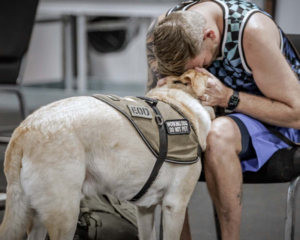 The benefit of human-animal bond for Veterans has a long history in the United States. Animal-assisted therapy dates back to at least 1919 when dogs were part of therapeutic interventions for psychiatric patients. Since then, dogs have assisted physically disabled veterans, participated in a variety of animal-assisted programs, helped rehabilitate soldiers while training service dogs for others, and provided stress control for deployed combat units.
The benefit of human-animal bond for Veterans has a long history in the United States. Animal-assisted therapy dates back to at least 1919 when dogs were part of therapeutic interventions for psychiatric patients. Since then, dogs have assisted physically disabled veterans, participated in a variety of animal-assisted programs, helped rehabilitate soldiers while training service dogs for others, and provided stress control for deployed combat units.
Dogs have a predetermined willingness to observe human faces and make eye contact. As a result, both dogs and humans pay attention to others in social interactions using their tactile-kinesthetic, visual, auditory, and communication abilities. Cognition studies show that dogs are able to interpret complex social interaction cues such as cross-pointing, reverse directions, and different arm extensions. Even when a person is unaware of his or her involuntary movements, the dog is watching the non-verbal signals, considering them a priority – higher than a consciously spoken word or manifested gesture.
A Randomized Trial of Differential Effectiveness of Service Dog Pairing
Department of Veteran Affairs, Office of Research and Development January 5, 2020